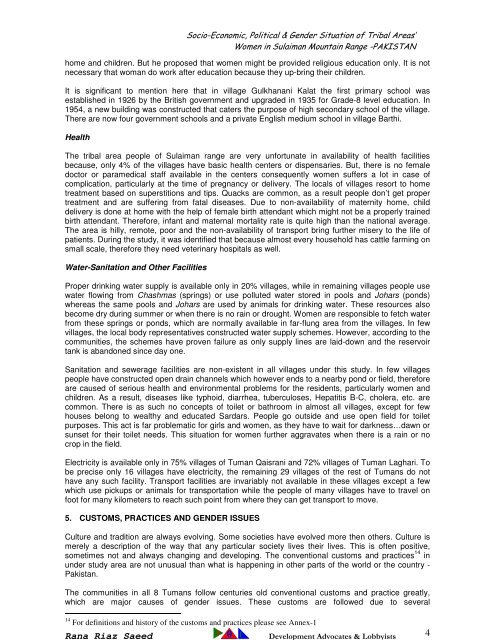Rana Riaz Saeed 1 - ResearchGate
Rana Riaz Saeed 1 - ResearchGate
Rana Riaz Saeed 1 - ResearchGate
Create successful ePaper yourself
Turn your PDF publications into a flip-book with our unique Google optimized e-Paper software.
Socio-Economic, Political & Gender Situation of Tribal Areas’<br />
Women in Sulaiman Mountain Range -PAKISTAN<br />
home and children. But he proposed that women might be provided religious education only. It is not<br />
necessary that woman do work after education because they up-bring their children.<br />
It is significant to mention here that in village Gulkhanani Kalat the first primary school was<br />
established in 1926 by the British government and upgraded in 1935 for Grade-8 level education. In<br />
1954, a new building was constructed that caters the purpose of high secondary school of the village.<br />
There are now four government schools and a private English medium school in village Barthi.<br />
Health<br />
The tribal area people of Sulaiman range are very unfortunate in availability of health facilities<br />
because, only 4% of the villages have basic health centers or dispensaries. But, there is no female<br />
doctor or paramedical staff available in the centers consequently women suffers a lot in case of<br />
complication, particularly at the time of pregnancy or delivery. The locals of villages resort to home<br />
treatment based on superstitions and tips. Quacks are common, as a result people don’t get proper<br />
treatment and are suffering from fatal diseases. Due to non-availability of maternity home, child<br />
delivery is done at home with the help of female birth attendant which might not be a properly trained<br />
birth attendant. Therefore, infant and maternal mortality rate is quite high than the national average.<br />
The area is hilly, remote, poor and the non-availability of transport bring further misery to the life of<br />
patients. During the study, it was identified that because almost every household has cattle farming on<br />
small scale, therefore they need veterinary hospitals as well.<br />
Water-Sanitation and Other Facilities<br />
Proper drinking water supply is available only in 20% villages, while in remaining villages people use<br />
water flowing from Chashmas (springs) or use polluted water stored in pools and Johars (ponds)<br />
whereas the same pools and Johars are used by animals for drinking water. These resources also<br />
become dry during summer or when there is no rain or drought. Women are responsible to fetch water<br />
from these springs or ponds, which are normally available in far-flung area from the villages. In few<br />
villages, the local body representatives constructed water supply schemes. However, according to the<br />
communities, the schemes have proven failure as only supply lines are laid-down and the reservoir<br />
tank is abandoned since day one.<br />
Sanitation and sewerage facilities are non-existent in all villages under this study. In few villages<br />
people have constructed open drain channels which however ends to a nearby pond or field, therefore<br />
are caused of serious health and environmental problems for the residents, particularly women and<br />
children. As a result, diseases like typhoid, diarrhea, tuberculoses, Hepatitis B-C, cholera, etc. are<br />
common. There is as such no concepts of toilet or bathroom in almost all villages, except for few<br />
houses belong to wealthy and educated Sardars. People go outside and use open field for toilet<br />
purposes. This act is far problematic for girls and women, as they have to wait for darkness…dawn or<br />
sunset for their toilet needs. This situation for women further aggravates when there is a rain or no<br />
crop in the field.<br />
Electricity is available only in 75% villages of Tuman Qaisrani and 72% villages of Tuman Laghari. To<br />
be precise only 16 villages have electricity, the remaining 29 villages of the rest of Tumans do not<br />
have any such facility. Transport facilities are invariably not available in these villages except a few<br />
which use pickups or animals for transportation while the people of many villages have to travel on<br />
foot for many kilometers to reach such point from where they can get transport to move.<br />
5. CUSTOMS, PRACTICES AND GENDER ISSUES<br />
Culture and tradition are always evolving. Some societies have evolved more then others. Culture is<br />
merely a description of the way that any particular society lives their lives. This is often positive,<br />
sometimes not and always changing and developing. The conventional customs and practices 14 in<br />
under study area are not unusual than what is happening in other parts of the world or the country -<br />
Pakistan.<br />
The communities in all 8 Tumans follow centuries old conventional customs and practice greatly,<br />
which are major causes of gender issues. These customs are followed due to several<br />
14 For definitions and history of the customs and practices please see Annex-1<br />
<strong>Rana</strong> <strong>Riaz</strong> <strong>Saeed</strong> Development Advocates & Lobbyists 4
















